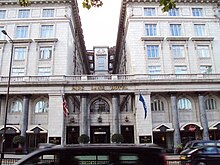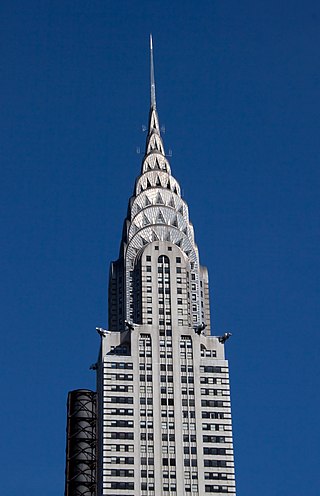
Art Deco, short for the French Arts décoratifs, is a style of visual arts, architecture, and product design, that first appeared in Paris in the 1910s, and flourished in the United States and Europe during the 1920s to early 1930s. Through styling and design of the exterior and interior of anything from large structures to small objects, including how people look, Art Deco has influenced bridges, buildings, ships, ocean liners, trains, cars, trucks, buses, furniture, and everyday objects including radios and vacuum cleaners.
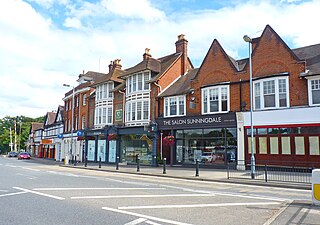
Sunningdale is a village and a civil parish in the Royal Borough of Windsor and Maidenhead. It takes up the extreme south-east corner of Berkshire, England and is adjoined by green buffers including Sunningdale Golf Club and Wentworth Golf Club. Its northern peripheral estates adjoin Virginia Water Lake.

Broadcasting House is the headquarters of the BBC, in Portland Place and Langham Place, London. The first radio broadcast from the building was made on 15 March 1932, and the building was officially opened two months later, on 15 May. The main building is in Art Deco style, with a facing of Portland stone over a steel frame. It is a Grade II* listed building and includes the BBC Radio Theatre, where music and speech programmes are recorded in front of a studio audience.
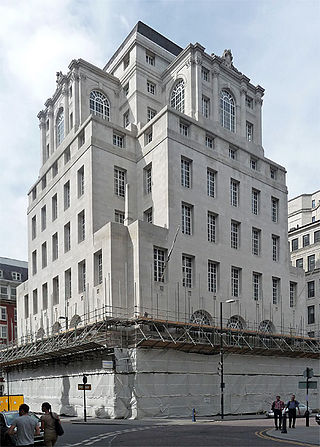
100 King Street, formerly the Midland Bank, is a former bank premises on King Street in Manchester, England. It was designed by Sir Edwin Lutyens in 1928 and constructed in 1933–35. It is Lutyens' major work in Manchester and was designated a Grade II* listed building in 1974.

Wallis, Gilbert and Partners was a British architectural partnership responsible for the design of many Art Deco buildings in the UK in the 1920s and 1930s.

Stockwell Garage is a large bus garage in Stockwell, in the London Borough of Lambeth, which opened in April 1952. At the time of construction it was Europe's largest unsupported roof span. The garage provides 73,350 sq ft (6,814 m2) of unobstructed parking space and could originally house 200 buses, required at a time when the last trams were being replaced by buses.

The Sheraton Grand London Park Lane is a 5 Star hotel on Piccadilly, London.

The Twentieth Century Society, founded in 1979 as The Thirties Society, is a British charity that campaigns for the preservation of architectural heritage from 1914 onwards. It is formally recognised as one of the National Amenity Societies, and as such is a statutory consultee on alterations to listed buildings within its period of interest.

The Daily Express Building, located on Great Ancoats Street, Manchester, England, is a Grade II* listed building which was designed by engineer Sir Owen Williams. It was built in 1939 to house one of three Daily Express offices; the other two similar buildings are located in London and Glasgow.

Saltdean Lido at Saltdean Park Road, Saltdean, in the city of Brighton and Hove, in the ceremonial county of East Sussex, England, is an Art Deco lido designed by architect R.W.H. Jones. Originally listed at Grade II by English Heritage for its architectural and historical importance, its status was upgraded further to "Grade II*" on 18 March 2011.

The Freemasons Tavern is a 19th-century pub in the Brunswick Town area of Hove, part of the English city of Brighton and Hove. Built in the 1850s in a Classical style similar to the surrounding buildings in the rapidly growing Brunswick Town area, it was given a "spectacular" renovation when a restaurant was added in the 1920s. Local architecture firm Denman & Son designed an ornate Art Deco interior and an elaborate, brightly coloured entrance adorned with Masonic symbols; both the exterior and the interior survive in excellent condition. The tavern is a Grade II Listed building.
Thomas Arthur Lodge (1888–1967) was a British architect.

The Brotherton Library is a 1936 Grade II listed Neoclassical building with some art deco fittings, located on the main campus of the University of Leeds. It was designed by the firm of Lanchester & Lodge, and is named after Edward Brotherton, 1st Baron Brotherton, who in 1927 donated £100,000 to the university as funding for its first purpose-built library.
Clayton & Black were a firm of architects and surveyors from Brighton, part of the English city of Brighton and Hove. In a career spanning the Victorian, Edwardian and interwar eras, they were responsible for designing and constructing an eclectic range of buildings in the growing town of Brighton and its neighbour Hove. Their work encompassed new residential, commercial, industrial and civic buildings, shopping arcades, churches, schools, cinemas and pubs, and alterations to hotels and other buildings. Later reconstituted as Clayton, Black & Daviel, the company designed some churches in the postwar period.
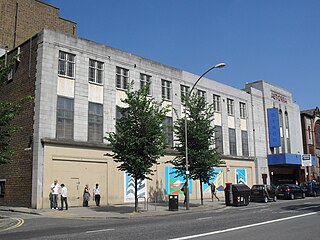
The Astoria Theatre was a former cinema in Brighton, part of the English coastal city of Brighton and Hove. Built in 1933 in the Art Deco style for a local entertainment magnate who opened one of Brighton's first cinemas many years earlier, it was the first and most important expansion of the Astoria brand outside London. It initially struggled against the town's other "super-cinemas", but enjoyed a period of success in the 1950s and 1960s before rapid decline set in, culminating in its closure in 1977.
George Mountford Adie was a British architect, the co-founder of Adie, Button and Partners in Mayfair, London.
Frederick C. Button ARIBA (1901–1969) was a British architect, the co-founder of Adie, Button and Partners.

Towers Cinema was a former cinema in Hornchurch, England. It was built in 1935 on part of the former Grey Towers estate and was noted for its Art Deco style of architecture. From 1973 it was used as a bingo hall until it closed in 2015. Despite the efforts of a local campaign to preserve the structure and to have it listed by Historic England, the building was demolished to make way for a Lidl supermarket.
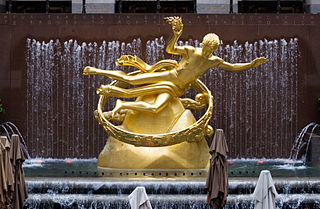
The Art Deco style, which originated in France just before World War I, had an important impact on architecture and design in the United States in the 1920s and 1930s. The most notable examples are the skyscrapers of New York City, including the Empire State Building, Chrysler Building, and Rockefeller Center. It combined modern aesthetics, fine craftsmanship, and expensive materials, and became the symbol of luxury and modernity. While rarely used in residences, it was frequently used for office buildings, government buildings, train stations, movie theaters, diners and department stores. It also was frequently used in furniture, and in the design of automobiles, ocean liners, and everyday objects such as toasters and radio sets.
Charters House is a Grade II listed building overlooking Sunningdale, Berkshire, built in 1938. The architects were George Adie and H. G. Hammond of Adie, Button and Partners.
